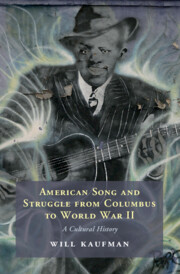Book contents
- American Song and Struggle from Columbus to World War II
- American Song and Struggle from Columbus to World War II
- Copyright page
- Praise for American Song and Struggle
- Dedication
- Contents
- Figures
- Preface
- Acknowledgments
- Introduction
- Chapter 1 Broken Spears and Songs of Sorrow
- Chapter 2 Good Newes from Virginia
- Chapter 3 A Capital Chop
- Chapter 4 If I Had but a Small Loaf of Bread
- Chapter 5 Where Today Are the Pequot?
- Chapter 6 There Is a Fountain Filled with Blood
- Chapter 7 A Tragedy That Beggared the Greek
- Chapter 8 Muscle, Blood, and Steel
- Chapter 9 Rule Anglo-Saxia
- Chapter 10 The Hand That Feeds You
- Chapter 11 We Are Many
- Chapter 12 100% American
- Chapter 13 We’re Up Against It Now
- Chapter 14 The Panic Is On
- Chapter 15 To Thee We Sing
- Conclusion
- Notes and Sources
- Song Index
- General Index
Chapter 14 - The Panic Is On
Published online by Cambridge University Press: 30 July 2022
- American Song and Struggle from Columbus to World War II
- American Song and Struggle from Columbus to World War II
- Copyright page
- Praise for American Song and Struggle
- Dedication
- Contents
- Figures
- Preface
- Acknowledgments
- Introduction
- Chapter 1 Broken Spears and Songs of Sorrow
- Chapter 2 Good Newes from Virginia
- Chapter 3 A Capital Chop
- Chapter 4 If I Had but a Small Loaf of Bread
- Chapter 5 Where Today Are the Pequot?
- Chapter 6 There Is a Fountain Filled with Blood
- Chapter 7 A Tragedy That Beggared the Greek
- Chapter 8 Muscle, Blood, and Steel
- Chapter 9 Rule Anglo-Saxia
- Chapter 10 The Hand That Feeds You
- Chapter 11 We Are Many
- Chapter 12 100% American
- Chapter 13 We’re Up Against It Now
- Chapter 14 The Panic Is On
- Chapter 15 To Thee We Sing
- Conclusion
- Notes and Sources
- Song Index
- General Index
Summary
The Crash of ’29 has come, and the Depression anthem “Brother, Can You Spare a Dime?” is written. The Bonus Army marchers and Cox’s Army descend upon Washington, singing. Rural depression and desperation continue – in folk song, blues, Tin Pan Alley song, and corridos. In “Bloody Harlan,” Kentucky, Florence Reece demands to know “Which Side Are You On?” and Aunt Molly Jackson leads the way in singing the coal miners’ struggle into the national conscience. The nine “Scottsboro Boys” are imprisoned, one of whom – Olen Montgomery – writes his own harrowing “Jailhouse Blues” in condemnation. In New York, Aaron Copland and Charles Seeger agonize over the “correct” way to write revolutionary song, and Black composers Florence Price, William Dawson, and William Grant Still are faced with the mixed blessing of the success of the white-penned Porgy and Bess. The argument over primitivism continues in the Haitian operas of White and Matheus as well as Hall Johnson’s groundbreaking Run, Little Chillun. Down South, the spiritual is transformed into some of the world’s greatest struggle anthems, and John Handcox emerges as the “Sharecropper’s Troubadour” for the Southern Tenant Farmers Union. Strike songs resound across the West Coast and the industrial heartland, while the queer world swings to the defiant songs of Pansies and Bulldaggers.
Keywords
- Type
- Chapter
- Information
- American Song and Struggle from Columbus to World War 2A Cultural History, pp. 302 - 332Publisher: Cambridge University PressPrint publication year: 2022

